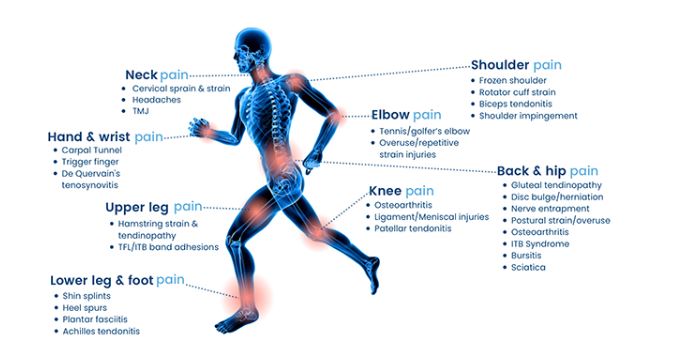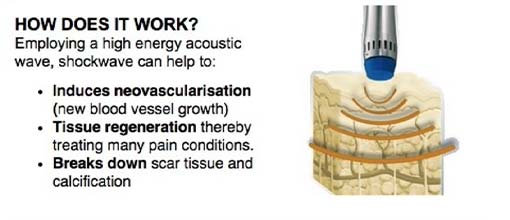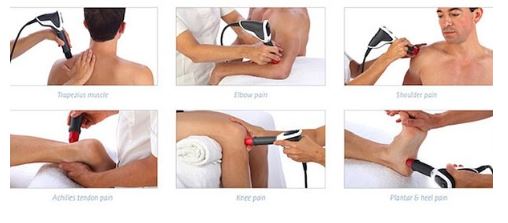Shockwave
Extracorporeal Myofascial Acoustic PulseTherapy (EMAP) aka Shockwave
A sound approach to treating musculoskeletal pain
Who Can Benefit?

What is it?
The word “extracorporeal” comes from two latin roots: extra (outside) and corp (body). So, treatment happens completely outside of the body.
As we age and put stress on our bodies through exercise, the tissues in our bodies can degenerate. Poor blood circulation, repeat injuries, overuse and weakness can also cause degeneration, and therefore poor healing. By exposing these injured tissues to specific sound waves, EMAP/Shockwave therapy can improve healing by increasing blood circulation.
EMAP or Shockwave therapy is a safe, non-invasive, and effective solution proven to speed up recovery time, eliminate pain, and restore full mobility for those suffering from many joint and tendon disorders. It uses short burst of high-energy sound waves to target the source of pain and stimulate your body’s natural healing process. Shockwave therapy increases blood circulationto bring oxygen and nutrients to the site of injury, breaks down scar tissue, and promotes cell regeneration. The resulting re-vascularization leads to faster healing, decreased sensitivity of pain receptors, and often a return to pre-injury activity levels—all without pills, injections, or surgery.
promote tissue regeneration by stimulatinghealing growth factors, stem cells, and the generation of collagen, a protein that provides structural support to tissues such as tendons and ligaments, further promoting healing. Thereby kickstarting the healing process in new and old injuries alike.
Whether you’re an athlete with a stubborn injury or someone battling chronic pain, shockwave therapy helps you get back to the things you love and stay there.


What to Expect
Does it hurt?
You will experience a sensation of mild rapid tapping discomfort. The process is very tolerable. Some short-term discomfort is felt during the treatment and some patients may experience temporary soreness, redness, or swelling for a few days following the procedure, but this is a healing reaction and should subside by the following day.Others may experience mild bruising, tingling or numbness over the area of treatment.These are generally mild and will go away.
How many sessions will I need?
The number of sessions required varies depending on the severity and chronicity (how long you have had the condition). Many patients report that they start to feela decrease in symptoms after just the first couple of treatments.Most patients need 4-10 treatments (roughly one week apart) for long-term success, but many experience immediate relief after their first session.After the treatment sessions are finished the injured area continues to heal for 6 to 18 weeks with maximal recovery occurring approximately 3 months after the treatment sessions end.
How long is each session?
About 5-10 minutes.
How effective is shockwave therapy?
Clinical studies report that over 71% of patients experience immediate relief, with over 91% reporting long-term success.
Safety
Very Safe! Shockwave therapy has no long-term negative side effects. Upon completion of your treatment session, you can return to most regular activities almost immediately, however for certain conditions we may advise you to avoid heavy strenuous activities for a day or two. No serious complications or side effects have been reported.
Research & Effectiveness
This FDA cleared technology was developed in Europe and is currently used around the globe. A wealth of medical experience, state-of-the-art engineering and optimal quality have been built into eachdevice, and extensive clinical studies and tests have confirmed its safety and efficacy.
Shockwave Therapy has received is presently employed by reputable institutions including:
- Mayo Clinic
- Orthopedic surgeons serving MLB, NFL, and NBA teams
- Cleveland Clinic
- UPMC (University of Pittsburgh Medical Center)
- Baylor University
- Georgetown University
- Northwestern University
- ANd numerous other respected organizations
Contraindiction Considerations
- Cortisone therapy up to six weeks before first treatment in the target area
- Use of oral or topical anti-inflammatory medication
- Immunosuppressant medication therapy
- Thrombosis - blood clot or on anticoagulants (esp. Marcumar)
- Pregnancy
- Pacemakers, electrical implant devices, metal implants
References
1. Cristina d’Agostino M et al. Shock wave as biological therapeutic tool: From mechanical stimulation to recovery and healing, through mechanotransduction. Int J Surg. 2015 Dec;24(Pt B):147-53.
2. Damian M et al. Trigger point treatment with radial shock waves in musicians with nonspecific shoulder-neck pain: data from a special physio outpatient clinic for musicians. Med Probl Perform Art. 2011 Dec;26(4):211-7.
3. Beyazal MS et al. Comparison of the effectiveness of local corticosteroid injection and extracorporeal shock wave therapy in patients with lateral epicondylitis. J Phys Ther Sci. 2015 Dec;27(12):3755-8.
4. Cacchio A et al. Effectiveness of Radial Shock-Wave Therapy for Calcific Tendinitis of the Shoulder: Single-Blind, Randomized Clinical Study. Phys Ther. 2006 May;86(5):672-82.
5. Rompe JD et al. Eccentric Loading Versus Eccentric Loading Plus Shock-Wave Treatment for Midportion Achilles Tendinopathy. A Randomized Controlled Trial. Am J Sports Med. 2009 Mar;37(3):463-70.
6. Furia JP et al. A single application of low-energy radial extracorporeal shock wave therapy is effective for the management of chronic patellar tendinopathy. Knee Surg Sports TraumatolArthrosc. 2013 Feb;21(2):346-50.
7. Gerdesmeyer L et al. Radial Extracorporeal Shock Wave Therapy Is Safe and Effective in the Treatment of Chronic Recalcitrant Plantar Fasciitis. Results of a Confirmatory Randomized Placebo-Controlled Multicenter Study. Am J Sports Med. 2008 Nov;36(11):2100-9.